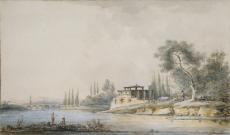


Watercolours have never in France enjoyed the autonomy – whether as a form of art, or even as a medium – that they have had in Britain. There has never been the purist view that has often held sway in the latter that they should be executed purely in watercolour, without the admixture of gouache, or bodycolour. It was not until the latter part of the eighteenth century that certain artists specialised in using watercolour for what it was most suited to: capturing the fleeting appearance of landscape. As Philippe Huisman pointed out in one of the few French works devoted to the subject, no dictionary or manual in France in the 18th century defined watercolour or issued guidance for its use, and the very word aquarelle was not used publicly until the 1770s. At the Salon des Grâces in the Colisée in 1776, Johann Anton de Peters (1725-1795) exhibited one picture under the heading ‘AQUARELLA’ and half a dozen more under the heading ‘PEINTURE MIXTE, AQUARELLA’, whilst Jacques-Philippe-Joseph de Saint-Quentin (b 1738) showed one ‘dessin aquarelle’; and the next year, at the true Salon, Gerard van Spaendonck (1746-1822) showed ‘Un Bouquet de fleurs peint sur papier, à l’aquarelle’. Significantly, none of these was a landscape, for which gouache, red or black chalk and Indian ink, or bistre wash, were preferred. The term more generally used then, and even later, for a watercolour was dessin coloré – which conveys something of its then character.
Louis Belanger, along with Louis-Gabriel Moreau, known as Moreau l’Aîné (1740-1806), Claude-Louis Châtelet (1753-1795) and Victor-Jean Nicolle (1754-1826), was what would now be called an ‘early adopter’ of watercolour for landscapes. Like the latter two, he was a great traveller – and watercolour is a particularly appropriate medium for making a variety of topographical depictions. His earliest such known production is a View of the Banks of the Saône near Lyons, signed and dated Bélangé à Lyon 1779, in the Musée des Beaux-Arts of Orléans, but in 2012 a Dutch-influenced River Landscape with a Herdsman and his Stock on a Road, in watercolour and bodycolour, signed and dated 1777, was auctioned in Paris. He went on to provide illustrations for the Description particulière et générale de la France (1781-1796); and travelled to Italy (1780-1785), where his sobriquet of ‘Belanger le Jeune’ was replaced with ‘Belanger le Romain’ (partly to distinguish him from his much older brother, François-Joseph Belanger [1744-1818], draughtsman of the Menus-Plaisirs and architect of the Château de Bagatelle); Switzerland (sometime in the 1780s); and England, calling himself originally ‘Painter to the Duke of Orléans’, where he exhibited at the Royal Academy in 1790 and 1797; before finally ending up, from 1798 onwards, in Sweden, where Gustavus Adolphus IV appointed him court painter and where he supplied illustrations for the uncompleted Voyage pittoresque de la Scandinavie (1802).
The curious character of the buildings in the present pair of watercolours suggests that they, by contrast, are not topographical views, but works of the imagination. The half-formed third digit of the date accompanying the signature on one of them, combined with its elision with the fourth digit and the pooling of the ink in its lower half, means that an ‘8’ has been mistaken for a ‘6’ – which would have meant that Belanger had painted them when he was only in his 11th year. The character of the landscape in each of them is perfectly compatible with France, but it is possible that the buildings were intended to suggest some more exotic location to a French audience.